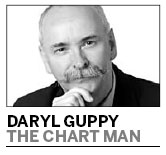Daryl Guppy
Investment speculators enter market in bigger numbers
By Daryl Guppy (China Daily)
Updated: 2010-12-13 11:21
 |
Large Medium Small |
 Normally we make a distinction between speculators, investors and traders. Now there is a fourth group emerging in the market and it has the potential to change market behavior. We call them the investment speculator and they include some of the largest fund managers and the new Exchange Traded Commodity Funds.
Normally we make a distinction between speculators, investors and traders. Now there is a fourth group emerging in the market and it has the potential to change market behavior. We call them the investment speculator and they include some of the largest fund managers and the new Exchange Traded Commodity Funds.
Investors usually take a long-term view of the market. They have a long-term investment horizon. They have faith and confidence in the company they buy and their capital helps the company to grow. Investment is similar to a long-term bank loan and the investor looks for capital growth and dividend income.
Traders are interested in short-term price movements, although if a trade is useful they may stay with the trend for weeks or months. Generally traders have a shorter time horizon and they are mainly interested in capital gain. Their activity helps provide liquidity in the market because the investors tend to buy stock and hold on to it for a long time.
The speculator buys with the intention of making a large profit as shortages hit the market. It might be a shortage in rice because of a drought, a shortage in oil because of disruptions by war or weather. The speculator does not care about the market trend or the quality of a company.
The investment speculator is not a contradiction. This group takes long-term speculative positions in futures markets because they believe the price of a commodity or metal will increase. They are active as commodity funds in the futures markets and their activity causes a bubble to develop. They buy short-term futures contacts and roll them into long-term contracts. This drains liquidity from the market. Genuine futures traders who use futures contracts to hedge against price movements have to compete for a smaller and smaller number of contracts so they can do their business. The result is a fast developing bubble as seen in the oil market in 2008. This was created by the 'swaps loophole' which allows long-term accumulation of what was designed as short-term contracts. It was the threat to close this loophole that created the collapse in the oil price from $145.
The new bubble threat comes from the launch this week in London of several Exchange Traded Funds that will hold physical copper and other metals. A commodity that is mined or produced for practical purposes, such as construction or consumption, moves into a bubble when it is purchased for its investment value. This is speculation activity.
There are always participants in the futures market who use the market for speculation but the futures market is usually liquid enough to prevent the speculators from dominating the price activity.
| ||||
The Exchange Traded Commodity Fund in commodities is a little different. It is based on the same principle as an Exchange Traded Fund using an index, but the Exchange Traded Commodity Fund is backed by physically holding several key industrial metals. These are copper, nickel and tin. When investors buy this Exchange Traded Commodity Fund then the fund must also buy a quantity of the metal. JPMorgan bought $1.5 billion of copper last week as a foundation for its planned Exchange Traded Copper Fund.
These funds will buy and keep these commodities at a time when supply is already struggling to keep up with demand driven by the strong growth in China and other economies in Asia.
A futures contract may be settled in cash or by physical delivery of the commodity and there is a scheduled time for delivery. The Exchange Traded Commodity Fund does not include a time for delivery. The physical metals are hoarded. They are bought or sold depending on the trading activity of participants in the Exchange Traded Commodity Fund. This accumulation buying helps to squeeze the supply of key metals and push up prices.
When commodity investor speculators decide it is time to sell then this can accelerate a price retreat. The Exchange Traded Commodity Fund must sell its physical holdings into a falling market and this can contribute to a faster price retreat.
Whether we agree or disagree about the morality of investor speculation, one thing remains clear. This is a new influence on commodity market pricing and many fear it will add to price pressures and volatility.
The author is a well-known international financial technical analysis expert.



